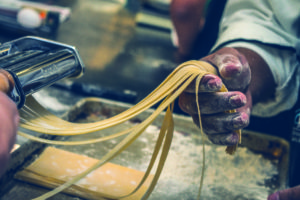There’s something deeply satisfying about making fresh pasta from scratch. While store-bought pasta is quick and easy, the taste and textures of homemade pasta can’t be beaten. When made right, it’s softer, silkier and absorbs pasta sauce beautifully.
Whether you’re preparing a weeknight meal or hosting a dinner party, knowing how to make pasta is an impressive and handy skill. With the wide variety of pastas and sauces, mastering a basic homemade pasta recipe gives you a foundation for endless dishes.
We asked CAE teacher and European-trained chef Simone Mancin for tips on how to make the perfect pasta recipe. Plus, he’s shared a simple pasta dough recipe for you to easily follow.
Use type 00 flour
Good pasta starts with the right flour. Type 00 flour is a high quality, Italian flour that is the gold-standard for making pasta and pizza dough.
The 00 grading refers to how finely milled the flour is and how much of the wheat bran is removed. A 0 flour is coarser in texture, and a 000 flour has a powdery consistency. Type 00 flour is a balanced, everyday white flour that is finer than plain flour and will result in softer and more delicate pasta.
Invest in a pasta maker
Rolling pasta by hand is a labour of love, but using a pasta machine speeds up the process and makes handling pasta dough easier. A pasta machine will help you achieve consistent pasta size and thickness that is near-professional in result.
Additional tip: If you’re rolling dough for the first time, it helps to have a second pair of hands – one person to turn the crank and one to guide and catch the pasta to avoid it stretching or tearing.
HOW TO BOIL PASTA
Perfect pasta should have as little contact as possible with water to give your pasta a better texture.
Here are three key rules to cook pasta al dente (firm to the bite).
- Boil first. Always wait until the water is boiling before adding pasta to the pot.
- Add salt generously. Once it has reached boiling point, add salt to the water. Salt allows water to reach a higher boiling point and seasons the pasta from the inside.
- Don’t add oil to the water. Adding oil to your water will coat pasta and prevent it from absorbing sauce.
And how long does it take to cook pasta?
If you follow this method the pasta shouldn’t take more than 2 to 3 minutes to become al dente.
Additional tip:
A way to stop the pasta from sticking together is to add more water when cooking pasta. Use 1 litre of water per 100 grams of pasta to help dilute starches (which is what causes pasta to stick together).
Don’t rinse your pasta
When the pasta is cooked, drain the water over the sink using a colander. Never rinse pasta. Rinsing removes surface starch that helps sauce cling to the pasta, and it will also cool the pasta and stop it cooking from residual heat.
The only times you would consider rinsing pasta is if it is sticking together, if it’s been overcooked (and you need to stop the cooking process), or if you’re making a cold pasta dish.
Now you know these basic tricks, it’s time to start practising your skills with Simone’s easy pasta dough recipe!
Pasta dough recipe
Ingredients
- 600g 00 flour
- 6‐7 eggs
- Olive oil
- Salt
- Extra flour (to work the dough)
- Water (if needed)
Method
- Place flour into a metal bowl
- Add the eggs, olive oil and a few pinches of salt to the flour
- Knead together until the dough is firm
- Place the dough onto a work surface and continue to knead for approximately 10 minutes
- If the dough is too soft and sticky, add a little flour. If too dry, add a little water
- Cover the dough with a damp cloth and rest for an hour
- After an hour, dust your work surface with a little flour and roll the dough until very thin (approx. 1mm). Alternatively, you can roll the dough through a pasta machine
- Cut pasta into desired strips or shapes
Note: If using the dough for ravioli or tortellini, Simone suggests adding quite a bit of water to create a softer dough. Softer dough is more elastic, holds (and sticks) better together and does not open as easily during cooking.
Simone Mancin is an Italian chef who loves teaching people how to cook. He started his career working in leading restaurants in Italy, England, France and Switzerland. In 2010, Simone travelled to Australia where he worked in Melbourne restaurants including Grossi Florentino, 400 Gradi and Locale at De Bortoli Winery.
Simone leads a range of exciting cooking classes at the CAE, which are hosted at our professional training kitchens in Box Hill!


